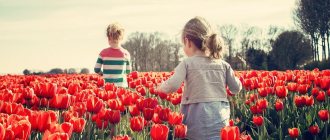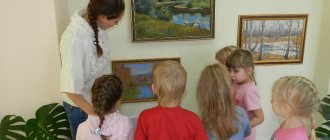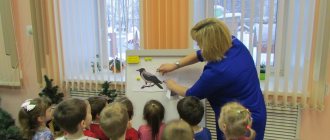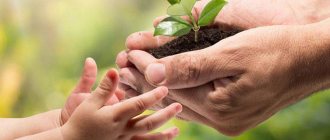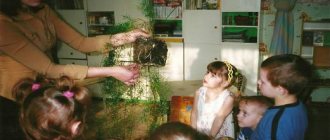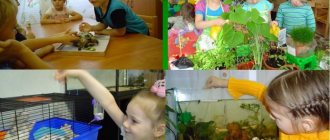Environmental education is an important component of the educational process in schools and kindergartens. Teachers organize their work in this direction both in the process of educational activities and in extracurricular activities. Forms, means and methods of environmental education are selected in accordance with the age of the children, the degree of their interest, and the natural environment.
Methods, forms and means of environmental education depend on the age of the children. The leading form of organizing work on environmental education is a lesson (class in a preschool educational institution). Experiences, experiments, observations, projects, the use of literature, conversations - those are the methods that the teacher uses in direct educational activities. In addition, in extracurricular activities. Extracurricular activities include excursions, holidays, themed leisure, and work with parents. All forms and methods can be used both in combination and separately.
Definition of the concept of environmental education
Environmental education is the inculcation of moral categories that are responsible for developing a caring attitude towards the environment in a person.
Environmental education should begin from preschool age, since it is at this moment that a person develops a set of basic moral values. Note 1
As part of environmental education, the child becomes familiar with the basic concepts of nature, realizes that he is part of this nature, and that people are responsible for almost everything that happens on our planet. The child must learn to take care of the environment. These goals and objectives are precisely realized within the framework of environmental education.
Are you an expert in this subject area? We invite you to become the author of the Directory Working Conditions
MAGAZINE Preschooler.RF
“Traditional and non-traditional forms of work on environmental education of preschool children”Cognitive development of preschool children and the formation of primary ideas about the world around them.
Educator: Svetlana Arkadyevna Lazovskaya. GBDOU kindergarten No. 6 Krasnogvardeisky district of St. Petersburg.
Content.
The main goal of environmental education is the formation of the child’s correct attitude towards the nature around him, towards himself as a part of nature. Love for nature, a conscious, careful and interested attitude towards it, should be cultivated from early childhood, therefore our kindergarten pays great attention to environmental education.
We have identified the following tasks:
- Formation of a conscious attitude towards nature in preschoolers.
- Improving the ability and skills of observing living and inanimate objects of nature;
- To develop ecological thinking and creative imagination in the process of experimental research activities of children;
- Develop basic standards of behavior in relation to the natural world and the environment in general.
The goal of environmental education is to form the foundations of an ecological worldview and ecological culture of preschool children.
In our opinion, ecology can be passed through all types of activities of a preschooler.
To help children in an entertaining way identify the features of natural phenomena, seasonal changes in nature, determine the qualities of an object, the habits of animals, we use riddles, poems, proverbs and sayings every day.
An important source of knowledge about nature is observation. In the process of observation, children learn to peer, admire, rejoice and admire the beauty of nature. They develop observation and curiosity, a kind, caring attitude towards natural objects. Observation makes it possible to introduce children to natural phenomena and the relationship between living and inanimate nature.
In our work on environmental education, we use various traditional and non-traditional forms, methods and techniques, taking into account the age and individual characteristics of children. To expand children's understanding of nature and expand their knowledge, we use an interactive whiteboard. With its help, children, due to its clarity, colorfulness and simplicity, can be transported to different countries and visually get acquainted with various natural phenomena, insects, flora and fauna.
But still, games are one of the most effective and most interesting means of environmental education for children. We use games of environmental content, first of all, for the purpose of clarifying, consolidating, generalizing, and systematizing knowledge. While playing, children better acquire knowledge about objects and natural phenomena, learn to establish relationships between them and the environment, learn about ways of adaptation of living beings to the conditions of their habitats, about the sequential change of seasons and about changes in living and inanimate nature.
Didactic games are a multifaceted and complex phenomenon. We use didactic games not only in children’s free activities, but also include them in direct educational activities (DEA), targeted walks, as well as in experimental activities of pupils. Games with various natural materials are very effective, they bring children as close as possible to nature, and always arouse keen interest and an active desire in children to play.
Health Days evoke special joy and interest among children. Where they, together with their parents, prepare fruit salads, do creative work using natural materials and, together with their parents, help maintain cleanliness and order in the kindergarten territory.
We also use experimental research activities in our work. This is the most exciting activity because... children are born explorers. And this is confirmed by their curiosity, constant desire to experiment, and desire to independently find a solution to a problem situation. Our task is not to suppress this activity, but, on the contrary, to actively encourage them, drawing their attention to the problem of environmental degradation. Children's experimentation is the cognition of the properties and connections of objects through various actions, which contributes to the development of thinking and other aspects of the child's personality. When he tries to do the experiment himself, he will remember it for a long time. Experiments can be carried out with all children at once.
In the nature center, children systematically observe and care for indoor plants and seedlings. In the process of care, children develop a careful, caring attitude towards nature, develop a responsible attitude towards their responsibilities, and gain ideas about the diversity of the plant world, how plants grow and develop, and what conditions need to be created for them.
The most effective way to implement the tasks of environmental education is to organize project activities. Our kindergarten has been participating in the long-term project “Lids of Kindness” .
Good Caps" is a Russian environmental and charitable volunteer project that has a dual goal: to make our world cleaner and to help children who need support. The project was organized jointly by the Public Movement “KIND LIDS” and the Charitable Foundation “Volunteers to Help Orphans” .
Our students, together with their parents, as well as all employees, collect ONLY plastic screw caps from drinking products (including drinking water) and caps from Immunele.
Here's how it works: plastic caps from bottles and jars are collected in a container that stands in groups. A large batch of caps is then sent to a plastic recycling plant. The plant weighs the raw materials and transfers funds for the collected caps to the account of the Volunteers to Help Orphans Charitable .
Who we help: This project “Lids of Kindness” has wards of the project “Close People” - these are children with special needs who are brought up in foster families. With these seemingly uncomplicated actions, our kindergarten helps not only protect nature, but also help people who find themselves in difficult life situations, and our pupils are the main good wizards for them.
During the warm season, our kindergarten implements the “Ekolyata” . Where are our students in June 2021? met nature conservationists. The Forest Fairy came to visit the children and introduced the children to her friends - defenders of Nature: Naughty, Clever, Quiet and Yolochka. They asked the children riddles, asked tricky questions, and offered difficult tasks. The children passed all the tests. And then the Forest Fairy said that they deserve to become members of the detachment of Nature defenders - preschool eco-children. During the summer and on warm autumn days, the children participated in creative workshops, quizzes and competitions, subordinated to the goals of nurturing love, caring and respectful attitude towards Nature.
The experience of our work has shown that purposeful, systematic work on environmental education of preschoolers, in an interesting, entertaining form, helps children see all the beauty of nature, reveal all its secrets and laws, instill in children kindness, a responsible attitude towards the world around them, the people who live near.
Thank you for your attention! I wish you all prosperity and goodness.
| Next > |
Forms of environmental education
There are the following forms of environmental education:
- educational activities
- excursions
- themed holidays
- getting to know nature in everyday life
- work activity
- exhibitions, competitions, olympiads
Educational activities are the leading method of introducing students to nature and the surrounding world. In the process of educational activities, the teacher systematically provides knowledge about natural phenomena and objects to children, taking into account their age, psychological characteristics and the specifics of the area in which the children live.
Classes can have several varieties:
- introductory lessons
- generalizing lessons
- in-depth educational lessons
During introductory lessons, students can become familiar with different species of animals, plants and natural phenomena that are not found in their area. During the lesson, the teacher uses a large number of visual aids. They help students develop correct ideas about the topic of the lesson.
Finished works on a similar topic
Course work Methods and forms of environmental education 400 ₽ Abstract Methods and forms of environmental education 230 ₽ Examination Methods and forms of environmental education 230 ₽
Receive completed work or specialist advice on your educational project Find out the cost
During a generalization lesson, children learn to generalize their knowledge regarding certain natural phenomena and objects. During this lesson, children learn to analyze, compare, and generalize.
During an in-depth cognitive lesson, children expand their knowledge of the phenomena that they see every day in everyday life. The teacher supplements the existing information with new information.
Excursions occupy a special place in the process of environmental education. During excursion lessons, children can get acquainted with natural phenomena in a natural setting. It is advisable to conduct excursions to the same places at different times of the year so that children can notice seasonal natural changes.
Themed holidays are very interesting for children and adults. They can be dedicated to a certain time of year, natural phenomena, animals, etc. The peculiarity of this form of work is that children develop a positive response to it in their consciousness.
In a preschool institution, during daily walks, the teacher introduces children to natural phenomena and materials, for example, children play in the sand, with snow, and with fallen leaves.
Labor activity occupies a special place in the process of environmental education. Labor activity is exciting for children; it can take place in the garden, vegetable garden or flower garden. Children can plant seeds, water plants, remove weeds, and harvest crops. Any work activity instills in children a love of work and independence, and in the process of environmental education, in addition, there is the formation of responsibility for the surrounding nature.
Children can take part in various competitions and quizzes, where they can demonstrate their knowledge about objects and natural phenomena, and children can also make crafts from natural materials.
Forms and methods of environmental education of preschool children in accordance with the Federal State Educational Standard for Education
Forms and methods of environmental education
children of preschool age in accordance with the Federal State Educational Standard of Education
Natalya Vladimirovna Merkulova, teacher of the MDOU TsRR-kindergarten No. 44 “Bell”, Serpukhov
Nature surrounds the child from an early age. A preschool child lives in a specific social, cultural, and natural environment. And the power of nature, its impact on the formation of a child’s personality is well known.
The ability to observe, developed in the process of learning about nature, gives rise to the habit of drawing conclusions and fosters the logic of thought. Children’s ability to compare, contrast, and draw conclusions improves, and a sense of beauty is formed.
In the process of environmental education, children develop cognitive actions, develop cognitive motivation and interest in the natural world, curiosity, creative activity, i.e. those personal qualities of the child that are presented as targets in the Federal State Educational Standard for Education. The goals and objectives of environmental education, as well as the content of the teacher’s work in this direction are reflected in the educational area “Cognitive Development”, sections “Acquaintance with Nature” and “Development of Cognitive Activity” of the Model General Educational Program for Preschool Education “FROM BIRTH TO SCHOOL”, as well as in OOP DOW.
Goals and objectives of environmental education
: Familiarization with nature and natural phenomena. Development of the ability to establish cause-and-effect relationships between natural phenomena. Formation of primary ideas about the natural diversity of planet Earth. Formation of elementary ecological ideas. Forming an understanding that man is part of nature, that he must preserve, protect and protect it, that everything in nature is interconnected, that human life on Earth largely depends on the environment. Developing the ability to behave correctly in nature. Fostering a love for nature and a desire to protect it. Development of children's cognitive interests, development of curiosity and cognitive motivation; formation of cognitive actions, development of imagination and creative activity; the formation of primary ideas about objects of the surrounding world, about the properties and relationships of objects of the surrounding world. Development of perception, attention, memory, observation, ability to analyze, compare, highlight characteristic, essential features of objects and phenomena of the surrounding world; the ability to establish the simplest connections between objects and phenomena, to make the simplest generalizations. A feature of the educational process in accordance with the Federal State Educational Standard is that the processes of education and training do not directly develop the child in themselves, but only when they have activity forms and have appropriate content. One way to improve the effectiveness of environmental development is to use a variety of methods and techniques. The teacher must be able to correctly select educational material and think through the methods and techniques with which he can best convey its content.
1. Basic forms of environmental education:
1.1 Direct educational activities
Classes are the leading form of organizing work to familiarize children with nature. They allow the teacher to form knowledge about nature in a system and sequence, taking into account the age characteristics of children and the natural environment.
There are several types of activities:
Primary orientation type of classes:
Most often, these classes are devoted to introducing children to species of animals, plants, their living conditions and habitats, which are not represented in the immediate natural environment and cannot be known through observation. The main component of such classes are various demonstration and teaching aids, i.e. clarity that allows children to form clear and correct ideas.
Generalizing type of classes
allows, in older preschool age, to form generalized ideas about objects and natural phenomena, identify a number of significant features for a group of familiar objects, compare, juxtapose, analyze, draw conclusions, and develop abstract thinking.
In-depth cognitive type of lesson:
These are classes that are built on a variety of specific knowledge acquired by children during observations in everyday life of natural objects from the immediate environment, and in which the teacher supplements the knowledge with new information and deepens it.
1.2 Excursions
Excursions are one of the main types of activities and a special form of organizing work to familiarize children with nature. The advantage of excursions is that they allow children to become acquainted with objects and natural phenomena in a natural setting. Excursions as a form of classes are conducted starting from the middle group. It is advisable to conduct nature excursions to the same places at different times of the year in order to show children seasonal changes in nature. The teacher plans an excursion based on the requirements of the program and the characteristics of the surrounding area.
1.3 Ecological holidays and leisure activities
The pedagogical meaning of holidays and leisure is to evoke in children a positive emotional response to their “natural” content. The scripts for these events use material that children are familiar with. More often than holidays, leisure activities are held on a variety of topics - they are organized by the teacher.
1.4 Introducing children to nature in everyday life
The teacher introduces the pupils to the daily changes of nature according to the seasons in the kindergarten area, organizes a variety of games with natural materials - sand, clay, ice, leaves, etc. Walks give the children the joy and pleasure of communicating with nature and help them feel its beauty.
In the group, it is necessary to create an appropriate RPPS, which provides for the construction of a variable developmental space, focused on the possibility of children freely choosing materials and participants in joint activities. It should be accessible, that is, provide students with free access to materials, manuals, and natural objects. Safe, i.e. all its elements must meet the requirements for ensuring reliability and safety of their use. And include not only a natural corner, but also a center of cognitive activity for experimenting with various materials, observing natural phenomena and inanimate objects. 1.5.
Labor Interesting and varied work is carried out in the flower garden and vegetable garden. Children observe plants, practice labor skills (watering plants, loosening, collecting seeds and harvests, etc.). This work has a great influence on the development of hard work, independence and mutual assistance. In senior and preparatory school groups, it is possible to organize site duties in the spring and summer or assign groups of children to a garden bed or flower bed. The teacher conducts work and observations in a corner of nature with children every day. The form of organization of activities is different (depending on age). Children, starting from the younger group, are involved in certain work assignments.
1.6
.
Organization of exhibitions and competitions of creative works 1.7.
Participation in children's environmental competitions and Olympiads 2. Methods of environmental education.
In the pedagogical process, various teaching methods are used: visual, practical, verbal. When introducing children to nature, all of these methods are widely used.
Towards visual methods
include observation, examination of paintings, demonstration of models, films, videos, presentations.
Practical methods -
This is a game, elementary experiments and simulation.
Verbal methods
- these are stories from the teacher and children, reading works of art about nature, conversations.
When working to introduce children to nature, it is necessary to use different methods in a complex and correctly combine them with each other. Visual methods
2.1 Surveillance
Observation is a specially organized by the teacher, purposeful, more or less long-term and systematic, active perception by children of objects and natural phenomena. The purpose of observation can be the assimilation of various knowledge - establishing the properties and qualities, structure and external structure of objects, the reasons for the change and development of objects (plants, animals), seasonal phenomena. It allows you to show children nature in natural conditions in all its diversity, in the simplest, clearly presented relationships.
Observation can be carried out both with individual children, with small groups (3-6 people), and with the entire group of pupils. Depending on the goals set by the teacher, observation can be episodic, long-term and final (generalizing). 2.2 Use of illustrative and visual material in working with children
Introducing children to nature, the teacher uses a variety of illustrative and visual materials: didactic paintings, reproductions of artistic paintings, photographs, slides, models, films and videos.
Illustrative and visual material helps to consolidate and clarify children’s ideas obtained through direct perception of natural phenomena. With its help, you can form knowledge about objects and natural phenomena that are impossible to observe at the moment or in a given area (wild or domestic animals of other climatic zones).
Practical methods
2.3 Simulation
Often, on the basis of sensory knowledge, it is necessary to “construct” in the mind an abstract, generalized idea of an object or a whole natural phenomenon, to draw up a diagram of the phenomenon being studied. Modeling helps the teacher successfully solve these problems as a method of introducing children to nature. It is based on the principle of replacing real objects with objects, schematic images, and signs.
2.4 Simple experiments and experimentation
To ensure that children’s knowledge about nature is conscious, simple experiments are used in kindergarten. Experience is an observation that is carried out in specially organized conditions.
Experiments contribute to the formation of children's cognitive interest in nature, develop observation and mental activity. In each experiment, the cause of the observed phenomenon is revealed, children are led to judgments and conclusions.
Experiments are most often carried out in older groups of kindergarten. In the junior and middle groups, the teacher uses only individual search actions.
Experience should always be built on the basis of existing ideas that children received in the process of observation and work. Its task and purpose should be clear to preschoolers. When conducting an experiment, the teacher should not cause harm or damage to plants and animals.
2.5 Introducing children to nature through games
A variety of games are widely used to introduce children to nature. In the practice of preschool education, several groups of games are used:
Didactic games-
games with rules and ready-made content. In the process of didactic games, children clarify, consolidate, and expand their existing ideas about objects and natural phenomena, plants, animals, and lead children to the ability to generalize and classify.
Desktop-printed
games are games like lotto, dominoes, cut and paired pictures. In these games, children’s knowledge about plants, animals, and inanimate natural phenomena is clarified, systematized, and classified.
Word games
- these are games the content of which is a variety of knowledge available to children, and the word itself. They are carried out to consolidate children’s knowledge about the properties and characteristics of certain objects.
Outdoor games of nature history
associated with imitation of the habits of animals, their way of life.
By imitating actions, imitating sounds, children consolidate knowledge; The joy gained during the game helps to deepen interest in nature. Experimental games
make it possible to verify the reliability of physical and natural phenomena and patterns (“Drowning - does not sink”, “Soap bubbles”, “Let’s make solutions”, “Which water is easier to swim in”) In older groups, competitive games can be successfully used
, games - trips. Verbal methods
2.6 Teacher’s story about objects and natural phenomena
During classes, excursions and walks, and in everyday communication with children, the teacher uses stories about nature. The main goal of this method is to create in children an accurate, specific idea of an object or natural phenomenon being observed at the moment or previously seen. The story is also used to inform children about new, unknown facts. The topic of the story is chosen by the teacher taking into account the content of knowledge determined by the kindergarten program. When composing a story, the teacher must take care to include in it not only words known to children, but also new ones that enrich their speech.
2.7 Use of natural history fiction
Fiction about nature has a deep impact on children's feelings. Getting acquainted with their content, children experience the course of events and mentally act in an imaginary situation. This helps to cultivate ethical ideas: love and respect for nature. The requirement for the method of using books, common to all age groups, is a combination of reading with direct observations in nature. After reading works of fiction, a conversation is organized about one or more books read.
2.8 Conversation as a method of introducing children to nature
Depending on the didactic goals, conversations about nature are usually divided into the following types: introductory, heuristic and final. Introductory conversation
helps the teacher gather children’s attention, arouse interest in the upcoming activity, update existing experience in order to establish a connection between previously acquired knowledge and the upcoming excursion, observation, etc.
Heuristic conversation
involves establishing the causes of various natural phenomena using reasoning. Such a conversation is based on the children’s existing knowledge gained during the observation process. It is aimed at deepening knowledge about the relationships that exist in nature, and children independently solving cognitive problems.
Final conversation
used to generalize and systematize children's knowledge about nature, obtained in the process of observations, games, reading works of art, work, etc. The final conversation is organized by the teacher, starting from the middle group.
It is carried out as children accumulate ideas about nature and only if these ideas are mastered by all children. 3. Project method
The project method allows children to gain experience on their own.
Learning takes the form of research, the application of existing knowledge in activities, the results of which are truly interesting to the child. Project activities make preschoolers active participants in the educational process and help them independently master the surrounding reality. By participating in projects, a child develops, learns to find a way out of a difficult situation and becomes more confident in his abilities. Tasks for the development of environmental culture can be realized using such forms and methods as
:
— environmental marathons, quizzes, KVN; - environmental actions, especially together with parents; — drawing up environmental maps and plans for ecological trails;
— environmental exhibitions and expositions;
— creation of environmental museums;
— environmental trainings;
— creation of environmental propaganda teams and “green patrol”; — collecting natural objects; — staging and theatrical performances on environmental topics; — meetings with representatives of professions related to environmental protection; — visiting exhibitions (pets, flower shows); - participation together with parents in holding exhibitions, making feeders and birdhouses with their subsequent placement on the territory of the kindergarten or in the courtyards of houses. 4.
Forms of work with parents on environmental education of preschool children.
The example of parents is of considerable importance in raising children. If parents deal with issues of environmental education, then their children will develop interest, love for nature and respect for it. Therefore, environmental education of children should take place in close cooperation with the child’s family. Jointly organized events not only help to ensure the unity and continuity of the pedagogical process, but also introduce into this process the special positive emotional coloring necessary for the child. When working with parents on environmental education of children, both traditional and non-traditional forms are used, but all these forms are based on the pedagogy of cooperation:
— Questionnaires, conducting surveys
— Round table discussions, parent meetings in a non-traditional form (talk shows, business games, pedagogical services bureau, direct telephone), — Consultations and environmental messages for the parent corner.
— Calendar of interesting dates—joint leisure activities, holidays, KVNs, quizzes, etc.
— Participation in exhibitions, shows and competitions.
— Involving parents in joint work with their children on the site and in the corner of nature.
- Production of newspapers, photo newspapers, environmental albums, posters, folders - travel documents.
Thus
, the formation of environmental consciousness, ecological culture is a long process, the beginning of this path is preschool childhood. The formation of the principles of ecological culture is the formation of a consciously correct attitude directly towards nature itself in all its diversity, towards the people who surround and create it.
And in conclusion, I would like to say that the most important thing in environmental education is the personal conviction of the teacher, the ability to interest and awaken in children and parents the desire to love, cherish and protect nature.
